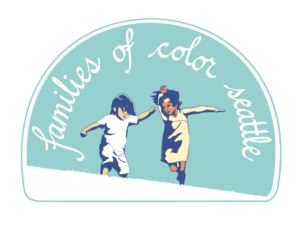
Since 2013, Families of Color Seattle has worked to build a loving community for Black, Brown, and Indigenous families in Seattle. Our work has connected 3,000+ families through parent affinity groups, workshops, community events, and more. As an organization dedicated to supporting families of color in Seattle and beyond, we are thrilled that Washington is now home to one of the best paid family and medical leave programs in the nation.
Washington’s Paid Family and Medical Leave Program provides workers with up to 16 weeks of paid time off to welcome a new child to their family (through birth, adoption, or foster care placement), care for a sick loved one, or to recover from their own serious medical condition. This means families can take time away from work to care for themselves or for family without losing a paycheck to do it.
This new program will have huge impacts in the lives of families of color. Previously, the only law providing for family or medical leave in Washington is the federal Family and Medical Leave Act (FMLA) which can provide up to 12 weeks of unpaid leave for those who qualify. But many families, particularly families of color, cannot afford to take unpaid leave if they are even able to qualify. According to the National Partnership for Women and Families, 62 percent of Black adults and 73 percent of Latinx adults are either ineligible for or cannot afford to take unpaid leave, compared to 60 percent of white adults. Black and Latinx workers are also more likely than white workers to have needed time away from work to care for family or for their own medical reasons but could not, most likely because they could not afford to lose pay or risk losing their job. In addition, the wealth gaps between the wealth of white families, and Latinx, Native and Black families are very high. Lack of access to paid family and medical leave makes them worse.
At the same time, women of color, especially Black, Latinx and Native, experience more negative perinatal outcomes such as pre-term births, and complications during pregnancy and birth. Moreover, Latinx, Indigenous and Black folks tend to experience more chronic health conditions, such as diabetes and asthma, and experience these health conditions earlier in their lives than white people. So when families of color can’t access paid leave to care for themselves or their families, it widens the racial wealth gap and the racial health gap between families of color and white families. Paid medical leave is a racial justice issue.
In Washington State, families can now take up to 16 weeks of paid family and medical leave when they need to care for themselves or their family members. Pregnant workers who experience pregnancy complications can take up to 18 weeks of paid leave. But this program will only be successful if families know how to access it. Read below to learn more about how you can access your benefits, and visit www.focseattle.org to learn more about our community work and parent support groups at Families of Color Seattle.
Who qualifies for leave?
Anyone who has worked at least 820 hours with one or multiple employers in the past year, including public, private, non-profit, and part-time employees, can receive Paid Family and Medical Leave. You do not need to be currently working to receive leave, you just need to have worked those 820 hours sometime in the past year.
Federal employees are not covered by the program. Self-employed individuals and federally recognized tribes can opt in and receive benefits too!
How much paid leave is available?
Each year, workers will be able to take:
- 12 weeks of paid family leave to bond with a new child after birth, adoption, or foster placement or to care for a seriously sick spouse, child (including adult children), sibling, parent, grandchild, or grandparent OR
- 12 weeks of paid medical leave to recover from their own serious medical condition (for example, child birth, surgery, dialisis, or a mental health crisis -- leave cannot be taken for a minor illness like a cold)
Workers can combine paid family and medical leave to receive 16 weeks of paid leave per year. However, birth parents who experience pregnancy complications can take up to 18 weeks of leave.
Is my employer required to hold my job for me when I take leave?
The leave is job-protected if you qualify for FMLA. To qualify for FMLA you must work at an employer with at least 50 employees, have worked there for at least 1 year, and have worked 1,250 hours in the past year. The paid leave benefits will continue regardless of if your employer chooses to protect your job or not.
Did you welcome a child in 2019? You can still take leave!
Importantly, workers who welcomed a new child into their families in 2019 -- whether through birth, adoption, or foster care -- are eligible to use the 12 weeks of family leave within the first year of the child’s life or within the first year of the child’s arrival in the home. However, it’s important to note that if you and your employer are not covered by the Federal Medical Leave Act (FMLA) or if your FMLA coverage runs out, this leave is not job protected. Individuals in this circumstance will need to work with their employer to take the time as they collect the paid benefit from the state.
What will my paycheck look like while I am out on leave?
Workers will receive a percentage of their regular wages, with low-income workers receiving 90% of their wages and higher income workers receiving a progressively smaller portion of their wages. The maximum weekly benefit is $1,000, meaning that workers earning more than $81,000 per year will receive no more than $1,000 per week.
How will I receive benefits?
When you want to take the leave, you will go to the Employment Security Department’s paid leave website at www.paidleave.wa.gov and apply for benefits. You will share what kind of leave you are taking (medical or family), upload paperwork to verify the need for leave (like a note from your doctor or midwife), and submit your application.
While you are on leave, you will receive your paycheck from the Employment Security Department, not your employer. While on leave, you will need to submit weekly leave claims to let the state know if you are still on leave or if you have returned to work.
Can you apply for paid leave benefits in languages other than English?
Yes. Workers can call the Employment Security Department (ESD) at (833) 717-2273. ESD will then connect with the state’s simultaneous interpretation service to provide interpretation in real-time. Staff can help workers access an application online, request a paper application, or help them connect with a local Work Source office to get help.
Are workers with an Individual Tax Identification Number (ITIN) eligible for benefits?
Yes. ITIN filers are eligible for benefits and will follow the same application process as other applicants.
Do the 820 hours have to be from the same employer?
No! If you have multiple jobs -- or had multiple jobs -- all of your hours worked count towards the 820 hours as long as they are with an employer who is not the federal government or a federally recognized tribe that hasn’t opted into the program.
I’m an independent contractor so this doesn’t apply to me right?
Independent contractors can qualify for benefits too! All you have to do is opt-into the program, report your hours to the state each quarter, pay the employee-portion of the premium (a few dollars a week), and you’re all set to receive the same benefits as everyone else!
Where can I learn more?
You can learn more about how the program will work and calculate your weekly benefit at MomsRising.org’s comprehensive paid leave resource website, available in English, Spanish, Chinese, Korean, Russian, Somali, and Vietnamese at www.momsrising.org/paidleavewa.
Christine Tang is the Director of Programs and Strategy for Families Of Color Seattle (FOCS). She is involved in developmental and educational advocacy for children of color, leads race and equity workshops, and has trained FOCS parent educators to support parents of color in community groups focusing on anti-racist parenting and raising resilient children of color.



The views and opinions expressed in this post are those of the author(s) and do not necessarily reflect those of MomsRising.org.
MomsRising.org strongly encourages our readers to post comments in response to blog posts. We value diversity of opinions and perspectives. Our goals for this space are to be educational, thought-provoking, and respectful. So we actively moderate comments and we reserve the right to edit or remove comments that undermine these goals. Thanks!